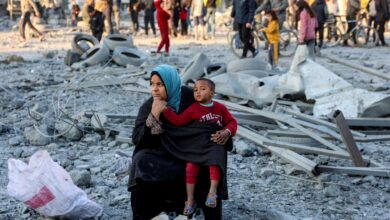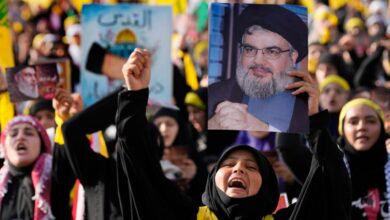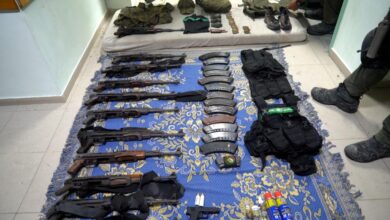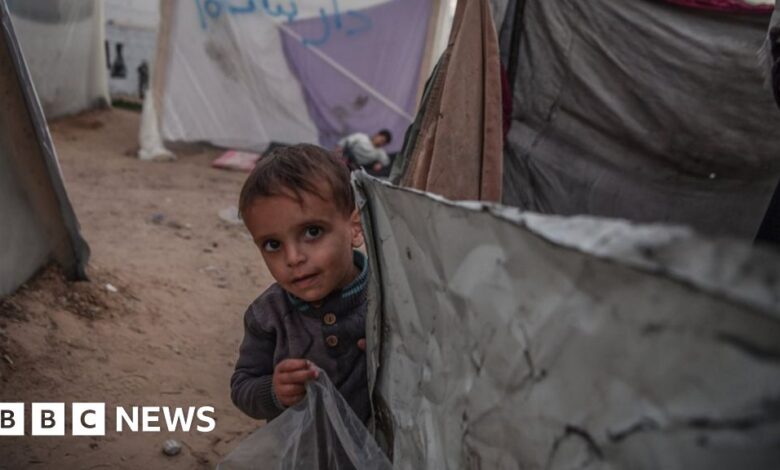
Israel Gaza War Aid A Complex Overview
Israel Gaza War Aid is a complex issue with a long history. From historical aid patterns to the current humanitarian crisis, this post delves into the intricacies of assistance provided during conflict. We’ll explore the different forms of aid, international responses, and the challenges in delivering and receiving support. The impact of aid on the conflict and the ethical considerations surrounding it are also examined.
This detailed analysis will explore the timeline of aid, types of support offered, and the current situation in the region. It will also examine the effectiveness of past aid efforts and identify the key actors involved in providing assistance. Furthermore, we’ll investigate the humanitarian needs, the potential impact on the conflict, and the mechanisms used to deliver aid.
Historical Context of Aid
The ongoing conflict between Israel and Palestine has a long history marked by cycles of violence and a persistent need for humanitarian assistance. Understanding the past patterns of aid is crucial to comprehending the present crisis and potential future responses. This historical context reveals recurring themes of disparity in aid distribution and the evolving role of international organizations.The provision of aid has been deeply intertwined with geopolitical factors and shifting global priorities.
Different eras have witnessed varying levels of commitment to resolving the conflict and providing equitable support to both sides. This historical analysis highlights the complexities of aid delivery and its impact on the ground.
Timeline of Aid Provided
The history of aid provided to both Israel and Palestine is complex, marked by shifts in international relations and the evolving nature of the conflict. Tracking the provision of aid reveals the different phases and priorities involved in this protracted issue.
- Pre-1967: Limited aid was provided, primarily focused on humanitarian needs and development projects. Financial assistance was often tied to specific political objectives, reflecting the limited international engagement with the region at the time.
- 1967-Present: Following the Six-Day War, aid to Israel significantly increased, encompassing both military and financial assistance. Aid to Palestine, however, remained largely humanitarian, often constrained by the ongoing conflict and political considerations.
- 1990s-2000s: The Oslo Accords and subsequent peace negotiations led to an increased focus on Palestinian development, including infrastructure and economic projects. However, these efforts were often hampered by the continuation of violence and political gridlock.
- 2010s-Present: The rise of the Israeli-Palestinian conflict, including periods of increased violence and conflict, has seen a significant rise in humanitarian aid to Palestinians. This period has also witnessed increased international condemnation of Israeli settlements.
Types of Aid Provided
The nature of aid has varied significantly, reflecting different priorities and goals. Understanding the different types of aid offered sheds light on the complex dynamics of the conflict.
- Financial Aid: This encompasses grants, loans, and other financial instruments used for various purposes, including economic development, infrastructure projects, and humanitarian relief efforts. The amount of financial aid to Israel and Palestine has differed greatly over time, reflecting geopolitical interests and priorities.
- Humanitarian Aid: This focuses on addressing immediate needs, including food, shelter, medical care, and basic necessities. Humanitarian aid is typically provided in response to crises and emergencies, and the allocation has varied based on the intensity of conflict and displacement.
- Military Aid: Military aid has played a significant role in the conflict. Israel has received substantial military aid from various countries, which has contributed to its military strength and capacity. Military aid to Palestine is minimal, reflecting the political constraints and limitations on armed forces.
Comparison of Aid to Israel and Palestine
The aid provided to Israel and Palestine has exhibited notable differences over time. This comparison highlights the disparities in the types and amounts of aid distributed.
| Category | Israel | Palestine |
|---|---|---|
| Financial Aid | Significantly higher, including grants, loans, and economic development assistance | Lower levels, often focused on humanitarian aid and reconstruction efforts |
| Humanitarian Aid | Received some humanitarian aid in specific crises, but often less than Palestinian needs | Significant humanitarian aid during conflicts, especially in refugee camps and during military operations |
| Military Aid | Substantial military aid from various countries, reflecting its security concerns | Minimal military aid, often limited by international restrictions and political constraints |
Role of International Organizations
International organizations have played a critical role in coordinating and delivering aid to both sides. The role of these organizations has varied over time.
- UN Relief and Works Agency for Palestine Refugees in the Near East (UNRWA): UNRWA has provided crucial humanitarian aid to Palestinian refugees, highlighting the long-term commitment to support refugees in the region.
- World Bank, IMF, and other development organizations: These organizations have often played a role in supporting development projects in both Israel and Palestine, albeit with differing levels of engagement and impact.
- NGOs: Numerous non-governmental organizations (NGOs) have been involved in providing humanitarian aid and development assistance, playing a crucial role in filling gaps in international support.
Historical Trends and Shifts in Aid Policies
The provision of aid to Israel and Palestine has been influenced by shifting geopolitical landscapes and international priorities. These trends highlight the complex factors that shape the allocation of aid.
- Cold War Era: Aid was often tied to geopolitical alliances, impacting both the quantity and types of aid provided to both sides.
- Post-Cold War Era: Aid focused more on humanitarian needs and development projects, though political considerations remained significant.
- Contemporary Era: Aid allocation is influenced by humanitarian crises, political tensions, and international efforts to promote peace.
Current Situation of Aid
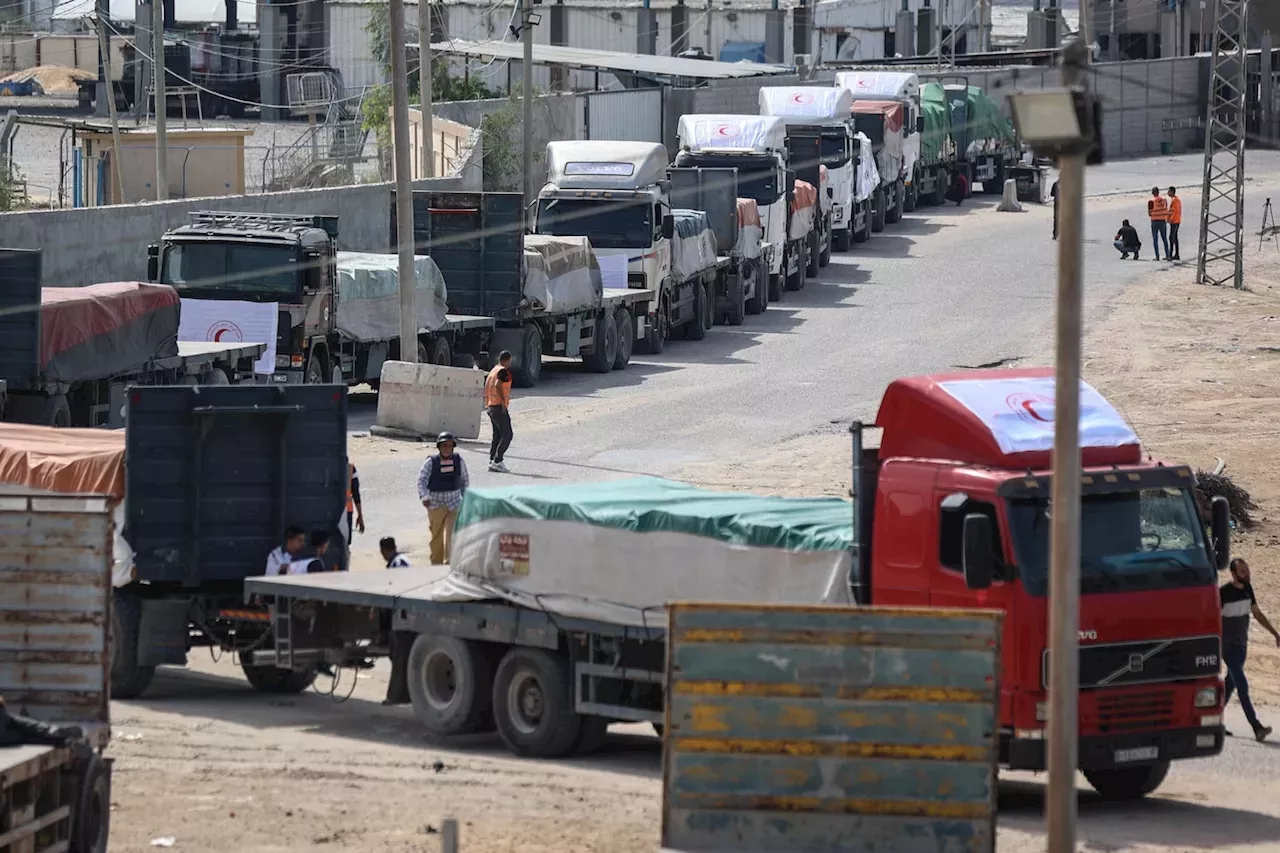
The recent Israel-Gaza conflict has highlighted the urgent need for humanitarian aid, and the complexities of delivering it effectively. The scale of devastation and displacement necessitates a coordinated and comprehensive response, but challenges in access, distribution, and coordination remain significant obstacles. This post examines the current state of aid efforts, including the actors involved, immediate needs, and the hurdles to overcome.The current aid effort is a multifaceted operation, encompassing a range of supplies and services, from food and shelter to medical care and psychosocial support.
However, the effectiveness of these efforts is heavily dependent on the delicate political situation and the capacity of organizations on the ground.
The ongoing Israel-Gaza conflict highlights the urgent need for aid, and while international efforts are crucial, a different kind of investment might offer valuable perspectives. Companies like KKR, known for their private equity strategies, are also exploring employee ownership models, like those discussed in this insightful article on kkr private equity employee ownership. This approach could potentially foster more sustainable solutions in the long term, echoing the need for lasting peace and rebuilding efforts in the region, especially after the conflict.
Current Level of Aid Provided
The volume of aid being delivered is substantial, but it’s not yet known if it adequately meets the enormous needs. Many international organizations and governments have pledged support, and some have already begun delivering crucial resources. The immediate priority is providing essential necessities to those affected, particularly in the areas most impacted by the conflict.
Key Actors Involved
Several organizations are involved in providing aid, including:
- International organizations, such as the United Nations (UN), the World Health Organization (WHO), and various humanitarian agencies, play a crucial role in coordinating and delivering aid.
- National governments, including those in neighboring countries and beyond, are contributing financial and logistical support to the relief effort.
- Non-governmental organizations (NGOs) are active in providing direct assistance to affected populations. Their knowledge of local needs and access to communities is often invaluable.
- Local communities and volunteer groups are frequently crucial in distributing aid and providing essential support on the ground. They possess an intimate understanding of the immediate needs of their communities.
Immediate Needs and Challenges in Providing Aid
The immediate needs are diverse and substantial. These include providing food, water, shelter, and medical care. Beyond these basic necessities, there’s a growing need for psychosocial support to address the psychological trauma of the conflict. The challenges in providing aid include:
- Security concerns often hinder the delivery of aid. Uncertainties about access and the safety of aid workers are common issues in conflict zones. Maintaining security and ensuring the safety of humanitarian workers is paramount.
- Logistical difficulties, such as access to impacted areas and coordinating the movement of aid supplies, pose significant challenges. These difficulties often arise from damaged infrastructure and ongoing conflict.
- Political and bureaucratic obstacles can slow down aid delivery. Negotiations and clearances can delay the distribution of vital resources, especially in politically tense situations. Clear communication and cooperation are essential.
Challenges in Accessing Aid
Access to aid can be extremely difficult for some populations due to various factors, such as the location of their residence or existing conflicts. Security concerns, political restrictions, and infrastructure damage can create significant obstacles to aid distribution.
- Limited access to certain areas is often a result of ongoing hostilities or security risks. The movement of humanitarian aid workers and supplies must be coordinated and prioritized to ensure their safety and effectiveness.
- Bureaucratic hurdles can impede aid access. Permits, approvals, and clearances can take significant time to obtain, potentially delaying or preventing aid from reaching those who need it most.
- Existing infrastructure damage can make access to some communities extremely challenging. The destruction of roads, bridges, and other vital infrastructure can severely restrict the ability to deliver aid.
Comparison with Previous Aid Efforts
Comparing the current aid efforts with previous ones reveals important differences. Previous humanitarian crises have often highlighted similar issues in terms of access and distribution. However, the scale and complexity of the current situation are significantly greater.
- The sheer magnitude of the crisis requires a larger and more coordinated aid response than seen in previous situations. The number of people affected and the level of destruction are unprecedented, requiring a more comprehensive approach.
- While previous efforts have involved similar actors and challenges, the political climate surrounding the current situation is more complex and fraught with potential obstacles. Understanding the political context is crucial for effective aid delivery.
Types of Aid: Israel Gaza War Aid
The conflict between Israel and Gaza has necessitated a multifaceted approach to aid, encompassing various forms to address the diverse needs of the affected populations. Understanding the different types of aid being provided is crucial to assessing its effectiveness and potential impact on the region. This examination delves into the various forms of aid, their implementation, and their associated challenges.The provision of aid in times of conflict often involves a complex interplay of financial, humanitarian, and military assistance.
Each type of aid serves a distinct purpose and has its own set of implications for the recipients and the broader geopolitical context.
Financial Aid
Financial aid plays a vital role in supporting the recovery efforts of affected communities. It provides crucial resources for rebuilding infrastructure, restoring livelihoods, and supporting essential services.
- Direct cash transfers to individuals and families can provide immediate relief and enable them to meet their basic needs. Examples include programs offering financial assistance for food, shelter, and medical care.
- Grants to organizations working on the ground, such as NGOs and aid agencies, provide funding for projects aimed at providing vital services and rebuilding communities. For instance, funding for hospitals and schools allows for restoration and rehabilitation efforts.
The effectiveness of financial aid often depends on its accessibility, transparency, and proper distribution mechanisms. Mismanagement or corruption can undermine the intended impact. Further, the rapid disbursement of funds is critical in addressing urgent needs. However, aid needs to be carefully planned and implemented to avoid exacerbating existing inequalities or hindering long-term development.
Humanitarian Aid
Humanitarian aid focuses on addressing the immediate and critical needs of the affected populations. It encompasses a broad range of support, from providing food and shelter to delivering medical care and psychosocial support.
- Emergency food supplies and water distribution are crucial in the aftermath of a crisis. Providing access to clean water and sanitation prevents the spread of disease and supports the basic necessities for survival.
- Provision of shelter and temporary housing assists displaced individuals and families. These measures provide temporary relief from harsh conditions, offering a safe haven until long-term solutions are established.
- Medical assistance, including the provision of medicines, medical supplies, and access to healthcare, is vital for treating injuries and addressing health concerns. Mobile clinics and emergency medical support can reach remote or inaccessible areas quickly.
The success of humanitarian aid relies on rapid response, effective coordination among aid organizations, and adherence to ethical principles. Cultural sensitivity and understanding are paramount for delivering aid that is truly helpful and respectful of local customs and needs. Challenges may include reaching remote areas, navigating security concerns, and dealing with logistical hurdles.
Military Aid
Military aid, while sometimes controversial, plays a role in ensuring the safety and security of aid workers and in providing support for defense capabilities.
- Military aid can include the provision of defensive equipment, training, and logistical support to the armed forces of a country. This support aims to improve their ability to maintain order and protect their citizens.
- Military aid may include the deployment of troops or personnel to help with security and logistical support for aid delivery. This support is crucial in ensuring the safety of humanitarian workers and preventing further harm to the population.
The effectiveness of military aid depends heavily on its strategic alignment with the humanitarian goals and the needs of the local population. Over-reliance on military aid may potentially worsen the situation if not managed properly. Furthermore, it’s crucial to balance security concerns with the preservation of civilian safety.
Aid Categories Table
| Aid Category | Specific Characteristics | Effectiveness Factors | Potential Risks/Challenges |
|---|---|---|---|
| Financial Aid | Monetary support for recovery efforts | Accessibility, transparency, efficient distribution | Mismanagement, corruption, inadequate planning |
| Humanitarian Aid | Addressing immediate needs (food, shelter, medical care) | Rapid response, coordination, cultural sensitivity | Reaching remote areas, security concerns, logistical hurdles |
| Military Aid | Security support, defense capabilities | Strategic alignment with humanitarian goals | Potential for escalation, undermining civilian safety |
International Response
The conflict in Gaza has triggered a significant international response, with various nations and organizations offering aid and support to the affected populations. This response, while commendable, has been marked by varying degrees of commitment and coordination challenges. The diverse approaches employed highlight the complex nature of humanitarian crises and the challenges in effectively delivering aid in conflict zones.The international community’s efforts to address the crisis in Gaza have been multifaceted, encompassing humanitarian assistance, diplomatic initiatives, and calls for accountability.
However, the effectiveness of these responses has been influenced by political sensitivities, differing national interests, and the ongoing complexities of the conflict.
The ongoing Israel-Gaza war aid efforts are crucial, but it’s important to remember the devastating human cost of conflict. Stories like that of lovers in Auschwitz, Keren Blankfeld and József Debreczeni, found frozen in a crematorium ( lovers in auschwitz keren blankfeld cold crematorium jozsef debreczeni ) serve as a stark reminder of the profound suffering inflicted by war.
Ultimately, any aid to those affected by the Gaza conflict needs to be accompanied by a commitment to peace and an end to all violence.
Varying Levels of Commitment and Support
Different countries and international bodies have demonstrated varying levels of commitment and support for the people of Gaza. Some nations have provided substantial financial and material aid, while others have been less forthcoming. These disparities reflect a range of factors, including political considerations, existing diplomatic relations, and the capacity to provide assistance. The level of commitment is not always directly proportional to proximity or historical ties.
Strategies and Approaches Employed
The international community has employed diverse strategies and approaches in its response to the Gaza crisis. Some countries have prioritized direct financial aid to alleviate immediate needs, while others have focused on providing medical supplies and personnel. Some nations have also sought to leverage diplomatic channels to mediate a resolution to the conflict.
Coordination and Collaboration
Coordination and collaboration between international actors have been a persistent challenge. Differences in priorities, political agendas, and bureaucratic processes have sometimes hindered effective joint efforts. The UN and other international organizations have played a crucial role in facilitating dialogue and coordinating assistance, but the fragmentation of the response remains a significant obstacle.
The ongoing Israel-Gaza conflict highlights the urgent need for international aid. While the global focus is understandably on humanitarian relief, it’s also interesting to consider how economies like China’s Hefei, a burgeoning EV city, china hefei ev city economy might be affected by global geopolitical shifts. Ultimately, the aid efforts for Israel and Gaza will require a multifaceted approach to address the complex issues at hand.
Role of the UN and Other International Bodies
The United Nations and other international bodies have taken on significant responsibilities in the crisis response. The UN Relief and Works Agency for Palestine Refugees in the Near East (UNRWA) has been instrumental in providing critical services to Palestinian refugees. Other UN agencies, such as the World Health Organization (WHO), have also been active in providing healthcare and other essential aid.
International organizations like the Red Cross and other humanitarian groups have played critical roles in delivering aid, providing medical assistance, and supporting the vulnerable. The varying mandates and capacities of these organizations have influenced the specific types of assistance offered. These organizations often collaborate with national governments and NGOs to ensure comprehensive aid delivery. However, bureaucratic procedures and differing perspectives on the conflict can sometimes hinder the effectiveness of their coordinated efforts.
Humanitarian Needs
The relentless conflict in Gaza has unleashed a devastating humanitarian crisis, impacting every facet of life for the civilian population. The scale of suffering is staggering, with profound implications for the region’s future. This section will delve into the critical humanitarian needs, focusing on the sectors most affected, the vulnerable populations, and the long-term consequences of this protracted conflict.
Healthcare Crisis
The healthcare system in Gaza is severely strained. Hospitals and medical facilities are often overwhelmed, lacking essential supplies, equipment, and trained personnel. The constant influx of casualties necessitates immediate and sustained medical attention, and the absence of sufficient medical resources threatens the lives of countless individuals. Essential medicines, surgical tools, and blood supplies are often in short supply, hindering treatment efforts and exacerbating the crisis.
The disruption to healthcare infrastructure is a significant impediment to recovery and long-term well-being.
Shelter and Housing
The conflict has led to widespread destruction of homes and infrastructure. Homes have been reduced to rubble, leaving families without safe and secure shelter. The displacement of populations further exacerbates the housing crisis. The immediate need for temporary housing and the long-term reconstruction of homes are crucial for restoring normalcy. This destruction has a cascading effect, impacting access to basic necessities like sanitation, clean water, and essential services.
Food Security and Nutrition
The conflict has disrupted agricultural production and access to markets, resulting in a severe food security crisis. The already fragile agricultural sector is further compromised, leading to a decline in food availability and affordability. Malnutrition is a growing concern, particularly among children and vulnerable populations. Food insecurity directly threatens the health and well-being of the population, particularly in the long term.
Vulnerable Populations
The conflict disproportionately impacts vulnerable populations, including children, women, the elderly, and people with disabilities. Children are particularly susceptible to the psychological trauma of the conflict, as well as the immediate and long-term health consequences of malnutrition and lack of access to healthcare. Women face unique challenges, including the loss of livelihoods, increased domestic violence, and the added burden of caring for their families.
The elderly and those with disabilities face significant challenges in accessing essential services, highlighting the need for tailored support and assistance.
Long-Term Impact
The conflict’s long-term impact on humanitarian needs is profound and far-reaching. The destruction of infrastructure and the disruption of livelihoods have long-term consequences for the region’s development and stability. The psychological trauma suffered by survivors can linger for years, impacting mental health and overall well-being. The displacement of populations and the disruption of social structures have long-term effects on families and communities.
Challenges in Delivering Aid
Delivering aid to the affected areas presents numerous challenges. Security concerns and logistical obstacles often impede access to vulnerable populations. Bureaucratic hurdles and political tensions can hinder the efficient delivery of aid, potentially delaying critical assistance. Coordination among aid organizations and governments is essential for ensuring the effectiveness and efficiency of aid efforts. The need for a coordinated and well-planned response is paramount for mitigating the suffering and ensuring a swift recovery.
Impact of Aid on the Conflict
Aid in times of conflict is a complex issue, often intended to alleviate suffering and promote peace but sometimes inadvertently exacerbating existing tensions. The delivery, distribution, and perceived fairness of aid can significantly influence the conflict dynamics, impacting not only humanitarian needs but also the political landscape. Understanding these complex interactions is crucial for effective aid delivery and achieving lasting peace.The effectiveness of aid in conflict zones is not solely dependent on the quantity or quality of the resources provided, but also on how it is managed and perceived by the affected parties.
This involves careful consideration of the political context, the existing power structures, and the potential for aid to be exploited or misused. Aid can unintentionally fuel conflict if it is not implemented with sensitivity to the local context. Conversely, well-targeted aid can foster trust and cooperation, paving the way for reconciliation.
Aid Contributing to Conflict Resolution
Aid can contribute to conflict resolution by addressing the root causes of the conflict, improving the living conditions of the affected population, and fostering trust between different groups. For instance, providing clean water and sanitation can reduce the spread of disease and improve public health, creating a more stable environment. Similarly, educational programs and economic development initiatives can empower individuals and communities, fostering a sense of hope and stability.
These actions can, in turn, create opportunities for dialogue and reconciliation between opposing sides. Successful examples exist where aid has played a crucial role in fostering peace, although each situation requires careful consideration of the unique context.
Potential for Aid to Escalate Tensions
Aid can inadvertently escalate tensions if it is perceived as biased or if it benefits one group more than another. Unequal distribution of resources can create resentment and mistrust, potentially fueling further conflict. Furthermore, aid can become a tool for political maneuvering if it is used to gain influence or support from international actors. Historically, such instances have led to increased tensions, with the aid itself becoming a battleground.
Aid programs should prioritize transparency and inclusivity to minimize the risk of exacerbating existing tensions.
Aid’s Influence on the Political Situation
The presence and type of aid can significantly influence the political situation in a conflict zone. Aid can empower certain groups or individuals, potentially altering the balance of power. The perception of aid as supporting a particular side can further polarize the conflict, leading to increased hostility. Furthermore, aid can influence the political decisions of both recipient and donor countries, impacting the conflict dynamics.
Understanding these potential influences is vital for creating aid strategies that do not inadvertently worsen the political situation.
Aid’s Role in Promoting or Hindering Peace Efforts
Aid can play a crucial role in promoting or hindering peace efforts depending on how it is implemented. Aid focused on reconciliation and dialogue can strengthen peace efforts by creating common ground and fostering trust between conflicting groups. Conversely, aid that reinforces existing power structures or perpetuates inequalities can undermine peace efforts and escalate tensions. For example, aid that strengthens the military capacity of one party can increase the likelihood of further violence, whereas aid focused on addressing economic inequalities and providing humanitarian assistance can promote stability.
Potential Unintended Consequences of Aid
Aid can have unintended consequences on the conflict, some of which can be negative. Aid may unintentionally reinforce existing power structures or benefit certain groups at the expense of others. For instance, aid focused on strengthening the military capacity of a particular faction may lead to an escalation of violence, rather than contributing to peace. Furthermore, aid that does not address the root causes of the conflict can be ineffective in the long term and may even lead to dependence on aid rather than self-sufficiency.
A thorough understanding of the local context and potential unintended consequences is essential for effective aid delivery.
Aid Delivery Mechanisms
Delivering aid effectively in conflict zones is a complex undertaking. The methods used, from direct distribution to intricate NGO networks, significantly impact the success of humanitarian efforts. Challenges include insecurity, logistical hurdles, and differing needs across diverse populations. Understanding these dynamics is crucial for ensuring aid reaches those most in need.The effectiveness of aid delivery hinges on meticulous planning, adaptation to evolving circumstances, and a nuanced understanding of the local context.
Different communities have varying needs and preferences, requiring flexible strategies to overcome barriers and ensure equitable distribution. Transparency and accountability are paramount in building trust and ensuring aid is used responsibly.
Different Methods of Aid Delivery
Aid delivery methods vary considerably, each with its own strengths and weaknesses. Direct distribution by government agencies or international organizations can be efficient for large-scale operations, but may lack local knowledge and responsiveness to specific needs. Working through NGOs, on the other hand, often fosters greater community engagement and tailored support, but can be hampered by bureaucratic processes and accountability concerns.
These methods are not mutually exclusive, and often a hybrid approach, combining various channels, is employed.
Challenges in Conflict Zones
Delivering aid in conflict zones presents a multitude of challenges. Insecurity, including armed conflict, often disrupts supply chains and restricts access to affected areas. Logistical obstacles, such as damaged infrastructure, limited transportation options, and bureaucratic red tape, can significantly delay or impede the delivery of aid. Building trust with local populations, navigating political sensitivities, and addressing potential corruption risks are critical for successful aid operations.
Examples of Successful and Unsuccessful Aid Delivery
Successful aid delivery often involves a combination of factors, including pre-existing relationships with local communities, flexible response to evolving needs, and transparent communication. For example, the early response to the Syrian civil war, though challenging, saw considerable aid reaching those in need through various channels. Conversely, unsuccessful attempts may be due to a lack of coordination between different aid organizations, a failure to understand local customs and sensitivities, or an insufficient understanding of the needs of specific populations.
An example of an unsuccessful strategy could involve a one-size-fits-all approach to aid distribution, neglecting local preferences and priorities.
Comparison of Aid Delivery Methods
| Aid Delivery Method | Strengths | Weaknesses | Examples of Success | Examples of Failure |
|---|---|---|---|---|
| Direct Distribution by Government/International Agencies | Efficiency, large-scale reach | Lack of local knowledge, potential for bureaucratic delays | Distribution of food in disaster relief | Ineffective aid distribution due to political restrictions |
| NGO-led Aid Distribution | Community engagement, tailored support | Bureaucratic processes, accountability concerns | Local health clinics run by NGOs in developing countries | NGOs struggling to adapt to changing conflict dynamics |
| Community-based Approaches | Strong local ownership, rapid adaptation | Limited resources, potentially exclusionary | Community-led water projects in post-disaster scenarios | Lack of funding for community-led efforts |
Key Actors in Aid Delivery
The aid delivery process involves a range of actors, each playing a critical role. Governments, both of the affected region and those providing aid, play a crucial role in facilitating access and providing logistical support. International organizations, like the UN, coordinate and provide funding. Non-governmental organizations (NGOs) work directly with communities, delivering aid on the ground. Local organizations and community leaders are essential for ensuring aid reaches those most in need and is culturally appropriate.
Media Coverage and Public Perception
The Gaza-Israel conflict, like many global crises, is heavily influenced by the media’s portrayal. Media outlets play a critical role in shaping public opinion and influencing aid efforts. The narrative surrounding aid, particularly during times of conflict, can significantly impact the allocation of resources and the overall response. Understanding how the media frames this aid is crucial to assessing its effectiveness and impact.Media coverage, whether intentional or not, often frames events in ways that resonate with pre-existing societal biases and concerns.
This can lead to a distorted view of the situation and influence public opinion in a way that may not accurately reflect the reality on the ground. The manner in which aid is presented to the public is paramount in shaping support and ultimately impacting the effectiveness of humanitarian efforts.
The Role of Media in Shaping Public Opinion
Media outlets, including television, newspapers, and online platforms, have a significant impact on public perception of aid efforts. News reports, analyses, and editorials often frame the narrative surrounding the conflict, impacting public understanding and support for aid initiatives. These narratives can significantly affect the allocation of resources, influencing policymakers and donor behaviour.
Common Narratives and Biases in Media Reports
Different media outlets and individuals often employ different narratives when reporting on aid efforts. These narratives can reflect underlying biases and pre-conceived notions. For example, some media outlets may focus on the bureaucratic hurdles in aid delivery, while others may emphasize the success stories of aid organizations. This selective highlighting of particular aspects can shape the public’s overall impression of the aid response.
The ongoing Israel-Gaza conflict highlights the urgent need for humanitarian aid, and the world’s response is crucial. While the global community rallies to support those affected, the intricate interplay of technological advancements like those in the FTC AI deals with Microsoft and OpenAI, ftc ai deals microsoft openai , are also shaping the future in ways we’re only beginning to understand.
Ultimately, the focus must remain on providing essential support to the people caught in the conflict.
Sometimes, media coverage might inadvertently promote or exacerbate existing societal biases, influencing public support and funding decisions.
Impact of Public Perception on Aid Policies and Funding
Public perception, influenced heavily by media coverage, can significantly impact aid policies and funding decisions. A positive perception of aid efforts can lead to increased funding and support, whereas a negative perception may result in reduced funding or even political pressure to redirect resources. Public opinion is a key driver of policy changes and donor commitments, impacting the scale and focus of humanitarian assistance.
For instance, if the public perceives a particular aid organization as inefficient, this could lead to decreased donations and a potential shift in funding priorities.
Social Media’s Role in Spreading Information about Aid Efforts
Social media platforms have emerged as powerful tools for disseminating information about aid efforts, allowing individuals to share their experiences and perspectives. Social media provides a platform for rapid dissemination of information, both accurate and inaccurate, potentially influencing public perception. The speed and reach of social media can amplify both positive and negative narratives, shaping the public’s understanding of the aid response.
Potential for Misinformation and Disinformation in Media Coverage
The rapid dissemination of information through social media and online platforms can unfortunately lead to the spread of misinformation and disinformation regarding aid efforts. This includes fabricated stories, manipulated images, and misleading statistics, potentially distorting public perception and hindering effective aid delivery. The potential for manipulation and fabrication is magnified in conflict zones, where access to accurate information can be limited.
The prevalence of this misinformation can undermine trust in aid organizations and the overall response.
Long-Term Solutions and Reconstruction
Beyond immediate relief, lasting peace and stability in Gaza and Israel require comprehensive reconstruction and sustainable development initiatives. This involves more than just rebuilding homes and infrastructure; it necessitates a holistic approach addressing the root causes of conflict and fostering a climate of trust and cooperation. A focus on economic empowerment and education is crucial to creating a future where conflict is less likely and prosperity is attainable for all.The reconstruction process must be carefully planned and implemented, with a strong emphasis on long-term sustainability.
This includes engaging local communities, respecting cultural sensitivities, and ensuring that projects are not simply temporary fixes but are part of a broader strategy for sustainable development.
Examples of Long-Term Aid Initiatives for Reconstruction
Various long-term aid initiatives can support reconstruction efforts. These include the development of vocational training programs, investment in small and medium-sized enterprises (SMEs), and the provision of micro-loans to entrepreneurs. Furthermore, building resilient infrastructure, such as improved water and sanitation systems, and sustainable agricultural practices, can contribute to long-term stability and well-being.
Importance of Sustainable Development
Sustainable development is critical for ensuring that aid efforts contribute to long-term well-being. This involves considering the environmental impact of reconstruction projects and implementing measures that promote ecological sustainability. For instance, renewable energy sources can provide long-term power solutions and reduce dependence on fossil fuels. This approach ensures that the reconstruction process doesn’t exacerbate existing environmental challenges.
Role of Economic Development in Peacebuilding
Economic development plays a pivotal role in peacebuilding. By creating economic opportunities, aid initiatives can reduce poverty, unemployment, and the potential for conflict. For example, the establishment of job training centers and the provision of financial assistance to small businesses can empower individuals and communities, fostering economic self-reliance and reducing the likelihood of future violence.
Importance of Infrastructure Development
Robust infrastructure is essential for fostering economic growth and improving the quality of life. Rebuilding essential services, such as roads, bridges, hospitals, and schools, is vital for restoring functionality and enabling the provision of basic services. This includes improving water and sanitation systems to address health concerns and enhance overall public health.
Key Considerations for Ensuring Long-Term Aid Effectiveness
Several key considerations are essential for ensuring that aid initiatives are effective in the long term. These include local ownership, community participation, and a focus on transparency and accountability. Engaging local stakeholders in the decision-making process and empowering local communities to manage and maintain the projects is crucial for their long-term success. This approach not only builds trust but also strengthens local capacity.
Moreover, ensuring that aid is channeled through transparent and accountable mechanisms is vital to prevent corruption and misuse of funds. A strong emphasis on local governance and participation ensures that aid is used effectively and efficiently.
Ethical Considerations
Navigating the complexities of providing aid during a conflict zone demands careful consideration of ethical principles. The act of delivering aid is not simply a humanitarian gesture; it is a delicate dance between meeting urgent needs and upholding ethical standards. This often involves navigating challenging situations where aid can be manipulated or exploited, potentially exacerbating the conflict instead of alleviating suffering.
Transparency and accountability are paramount in ensuring that aid reaches those who need it most and doesn’t inadvertently fuel the conflict.The ethical dilemmas surrounding aid delivery are multifaceted. The very act of providing aid can be perceived as taking sides, challenging the delicate balance of neutrality and impartiality that is crucial for effective and sustainable aid efforts. Moreover, there is a constant risk of aid being misused or exploited by warring factions, turning a humanitarian endeavor into a tool of political maneuvering.
These complexities highlight the need for careful planning, rigorous evaluation, and ongoing monitoring to ensure aid achieves its intended purpose.
Ethical Dilemmas in Conflict Zones
Aid organizations face numerous ethical dilemmas when operating in conflict zones. These dilemmas stem from the inherent challenges of delivering aid in unstable environments, where the very nature of the conflict can influence how aid is perceived and utilized. The competing needs of different parties, the risk of unintended consequences, and the inherent tension between impartiality and effectiveness all contribute to the ethical complexities.
The ongoing aid efforts for Israel during the Gaza war are crucial, but it’s easy to get caught up in the immediate crisis. It’s interesting to note how these global issues often intersect with seemingly unrelated pop culture phenomena like the recent buzz surrounding the “Godzilla Oppenheimer Heron Boy” godzilla oppenheimer heron boy discussion. Ultimately, the need for support for those affected by the conflict in Israel and Gaza remains paramount.
These dilemmas often require aid workers to make difficult choices in the face of uncertainty, demanding a high level of ethical awareness and decision-making.
Principles of Neutrality and Impartiality
Maintaining neutrality and impartiality is paramount in humanitarian aid delivery. This principle mandates that aid should be provided without discrimination based on political affiliation, ethnicity, religion, or other factors. It is crucial to ensure that aid reaches all those in need, regardless of their position in the conflict. Failure to uphold this principle can inadvertently perpetuate the conflict by creating divisions and further marginalizing certain groups.
Potential for Misuse and Exploitation
Aid can unfortunately be misused or exploited by warring parties for political gain or to enhance their strategic position. This can range from using aid to bolster recruitment efforts to diverting resources away from genuine humanitarian needs. The very presence of aid can be exploited as a bargaining chip in negotiations or as a source of leverage in the conflict.
Therefore, stringent oversight and transparent aid delivery mechanisms are essential to prevent misuse and ensure the integrity of the humanitarian effort.
Examples of Ethical Breaches, Israel gaza war aid
Unfortunately, instances of ethical breaches in aid delivery have occurred throughout history. One notable example involves the diversion of food aid in a conflict zone, where the aid was used to bolster the ranks of a particular armed group, rather than alleviating hunger among civilians. Other examples include the selective distribution of aid based on political considerations, the lack of transparency in aid allocation, and the use of aid to gain access to restricted areas or sensitive information.
Ethical Considerations for Aid Workers
| Ethical Consideration | Explanation |
|---|---|
| Impartiality | Aid should be provided without bias, regardless of political or social affiliations. |
| Transparency | Open communication and clear reporting of aid distribution are vital to accountability. |
| Accountability | Aid organizations must be answerable for their actions and the use of donated resources. |
| Due Diligence | Thorough investigation into the needs and potential vulnerabilities of the population in need. |
| Protection of Civilians | Prioritizing the safety and well-being of civilians above all other considerations. |
| Conflict Sensitivity | Understanding the dynamics of the conflict and the potential impact of aid on different groups. |
Closing Notes
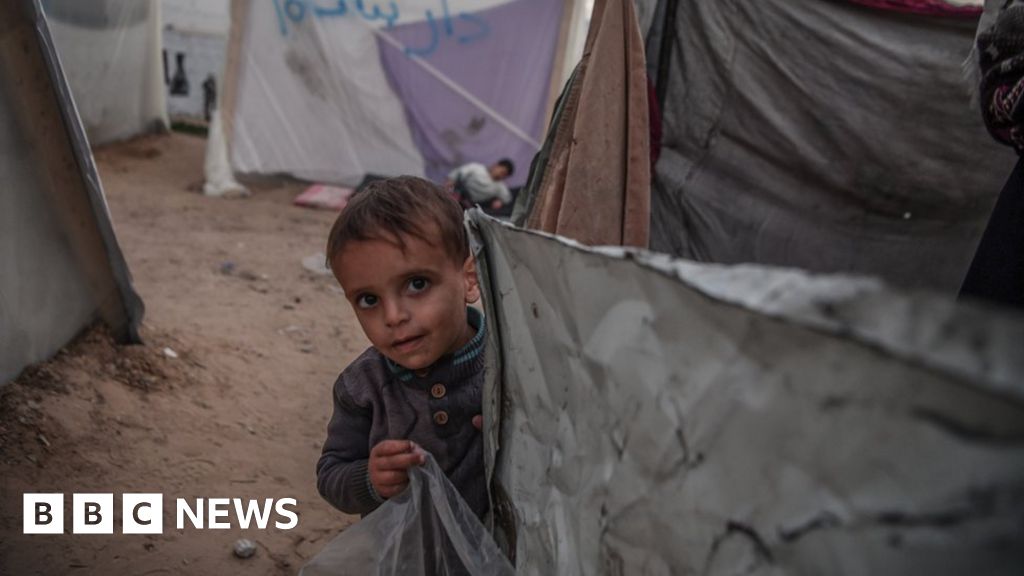
In conclusion, the Israel Gaza War Aid effort presents a multifaceted challenge, involving a complex interplay of historical context, current needs, and ethical considerations. Understanding the intricacies of aid delivery is crucial to its effectiveness in alleviating suffering and fostering peace. The multifaceted nature of the conflict requires a nuanced approach to aid, considering both the immediate needs and long-term solutions.
This overview has highlighted the critical need for ongoing, effective aid, alongside constructive dialogue to achieve lasting peace.
FAQ Resource
What are the main challenges in accessing aid during conflict?
Security concerns, bureaucratic hurdles, and political instability often hinder aid access. These obstacles can make it difficult for humanitarian organizations to reach those in need.
How has media coverage influenced public perception of aid efforts?
Media narratives can shape public opinion, sometimes highlighting specific aspects of the crisis or portraying aid efforts in a biased way. This can impact public support and funding for aid initiatives.
What are some examples of long-term aid initiatives for reconstruction?
Long-term initiatives can include rebuilding infrastructure, supporting economic development, and fostering education. These programs aim to create sustainable solutions that prevent future crises.
What ethical considerations must be taken into account when providing aid in conflict zones?
Neutrality, impartiality, and avoiding exploitation are paramount. Aid organizations must ensure that their efforts don’t exacerbate existing conflicts or further marginalize vulnerable populations.

